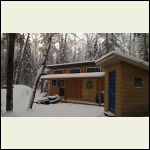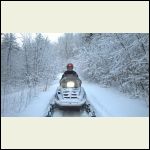| << . 1 . 2 . |
| Author |
Message |
Nobadays
Member
|
# Posted: 26 Feb 2021 11:03pm
Reply Quote
Quoting: rpe although perhaps one that needs to not be left unattended.
Actually it runs quite well unattended... just wouldn't recommend leaning a propane heater against the back of the heater where it can melt the plastic fuel lines! I have lots of hours on that heater both in our greenhouse where it was initially intended for and the shop. I think they are pretty safe.
|
|
rpe
Member
|
# Posted: 27 Feb 2021 07:11am
Reply Quote
Quoting: Nobadays Actually it runs quite well unattended...
Good to know. Will add this item to my list.
|
|
rpe
Member
|
# Posted: 14 Jul 2021 08:09am
Reply Quote
We dug out under the support beams for more clearance, and put down a layer of pea-stone around the bottom of the building. That greatly reduces messy splash from heavy rains.
My son used his new Alaskan mill to cut up a dead pine for posts, and we stained and installed at the front of the porch section. Next step is to finish burying power supply cable, and eliminate the extension cord currently powering the building. Then we can finish putting down deck boards.
|
|
rpe
Member
|
# Posted: 7 Feb 2022 03:52pm
Reply Quote
As a follow-up, adding more clearance under the support beams has solved the frost-heaving issues. The door opens without issue!
We have a propane torpedo heater that is used for quickly warming up the building, and a diesel 5kw heater that attempts to hold the temp once warmed up. The diesel heater isn't up to the task on its own, but would be fine in a smaller space. The drawback with the propane is the moisture it adds to the air. The tools and other metal bits in the workshop get damp very quickly. However, we can work on our old snow machines in temperatures above freezing, which is a real novelty!
WP_20220106_10_30_08.jpg
| 
WP_20220106_15_19_10.jpg
|  |  |
|
|
Shadyacres
Member
|
# Posted: 7 Feb 2022 04:05pm
Reply Quote
Me personally I think when you fill holes with gravel you basically have a pond of water that will freeze deep. I usually put some gravel on bottom but then soil , clay etc. on top to try to keep water out of holes. Looking good !
|
|
rpe
Member
|
# Posted: 7 Feb 2022 05:43pm - Edited by: rpe
Reply Quote
In our area, we are on bedrock, with 'soil' consisting of veins of clay, sand, and silt. The water table is only a few feet underground, as surface water percolates down to the bedrock, then flows towards the lake. Bedrock depth is from zero to about 8 ft. There's really no way to keep water out of many of the pier holes, as it's flowing just below the surface along the bedrock.
The granular backfill material doesn't support wicking of water from below the frost line up into the frost zone. That's what happens with fine soils when sub-frost zone water is present, and the freeze-crack-wick-freeze-crack-wick cycle continues all winter long.
I can see around my piers the adjacent soil surface is 4-6" higher than in summer, but the gravel ring around the pier remains down at its original height. Once the frost leaves the soil, it falls back to its original elevation. There's no way I'd put clay back in contact with those piers. They are one part of the frost-heave trifecta! (Freezing temps, sub-frost zone water source, fine particulate soil). The civil engineering papers I found said if you can truly eliminate any one of those three, the problem is solved.
Solutions to those three issues include:
1.) Foam panels surrounding each pier to prevent frost penetration
2.) Drainage systems and sump pumps drop water table in vicinity of the piers
3.) Excavation to bedrock with granular backfill.
I've used French drains to try to assist in sub-surface drainage, but our power is off for long periods over the winter, so the sump pump option is out. Burying foam just under the surface would be another option, but not very appealing to me. The granular backfill option has been working well thus far, although transportation of the gravel to the site is a challenge, being boat-access!
|
|
| << . 1 . 2 . |

